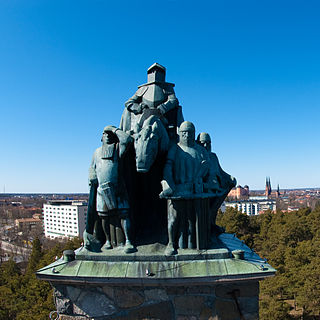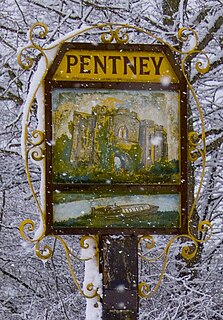
Margaret Leijonhufvud was Queen of Sweden from 1536 to 1551 by marriage to King Gustav I.

Sten Sture the Elder was a Swedish statesman and regent of Sweden 1470–1497 and 1501–1503. As the leader of the victorious Swedish separatist forces against the royal unionist forces during the Battle of Brunkeberg in 1471, he weakened the Kalmar Union considerably and became the effective ruler of Sweden as Lord Regent for most of his remaining life.

Christina Nilsdotter Gyllenstierna of Fogelvik was a Swedish noble and a heroine. She was married to the Swedish regent Sten Sture the Younger, and famously led the Swedish resistance against Christian II of Denmark after the death of her spouse. In her own lifetime she was simply referred to as Fru Kristina, but she has become known in history as "Kristina Gyllenstierna" because of the house of nobility to which she belonged.

Tynemouth Castle is located on a rocky headland, overlooking Tynemouth Pier. The moated castle-towers, gatehouse and keep are combined with the ruins of the Benedictine priory where early kings of Northumbria were buried. The coat of arms of the town of Tynemouth still includes three crowns commemorating the tradition that the Priory had been the burial place for three kings.

Kalmar is a city in the southeast of Sweden, situated by the Baltic Sea. It had 36,392 inhabitants in 2010 and is the seat of Kalmar Municipality. It is also the capital of Kalmar County, which comprises 12 municipalities with a total of 236,399 inhabitants (2015).

The Diocese of Linköping is a diocese within the Church of Sweden administering the Östergötland County, the north eastern part of Jönköping County and the northern part of Kalmar County. It comprises nine deaneries subdivided into 176 parishes with a total of 443,000 members. The dioecese's largest parish is Motala. The Diocese of Linköping has a rank directly below the Archdiocese of Uppsala of the Church of Sweden. The current bishop is Martin Modéus.

Erik Johansson Vasa was the Lord of Rydboholm Castle in Roslagen. He was born around the year 1470 to Johan Kristiernsson Vasa and Birgitta Gustafsdotter Sture in a village named Örby in the province of Uppland, Sweden. He was one of four children from Johan and Birgitta; Johan was first cousin of Charles VIII of Sweden's father, Knut.
Ulrika Eleonora Stålhammar, was a Swedish corporal and crossdresser who served in the Great Northern War. She was put on trial for having served in the military posing as a man and for marrying a woman. She has been the object of plays, literature, research and exhibitions.
Brita Zippel, also called Britta Sippel was an alleged Swedish witch, known as "Näslösan", one of the most famous figures of the great witch mania called "Det Stora oväsendet" in Sweden between 1668-1676, and the most famous of the city of Stockholm. Together with her sister Anna Zippel, she may be the most famous witch in Swedish history.

Lady Ingeborg Åkesdotter Tott or 'Ingeborg Aagesdotter of the Thott', in her lifetime called Ingeborg Åkesdotter or simply Fru Ingeborg, was a Swedish noble, the consort of the Swedish regent Sten Sture the elder. She was the fiefholder of Häme in Finland. She functioned as the de facto queen consort of Sweden for over three decades and participated in state affairs during the reign of her spouse.

Anna Rheinholdsdotter Leuhusen, was the Abbess of St. Clare's Priory in Stockholm. She became known for her involvement in the Swedish War of Liberation between Sweden and Denmark in the 1520s.

Margareta Eriksdotter Vasa, also called Margareta Vasa and Margareta of Hoya, was a Swedish noblewoman, sister of king Gustav I of Sweden. Between 1525 and 1534, she commanded Vyborg Castle on several occasions during the absence of her spouse.

Pentney is a village and civil parish in the English county of Norfolk, located about 8 miles (13 km) south east of King's Lynn placing it about halfway between King's Lynn and Swaffham on the A47 road. It covers an area of 10.39 km2 (4.01 sq mi) and had a population of 387 in 184 households at the 2001 census, increasing to 544 at the 2011 Census. For the purposes of local government, it falls within the district of King's Lynn and West Norfolk. It is in the valley of the River Nar, a tributary of the River Great Ouse.

St. Clare's Priory, Stockholm, was a Roman Catholic nunnery of the Poor Clares in Stockholm, Sweden that was active from 1289 to the Swedish Reformation in 1527.

St. Mary Magdalen was a Benedictine priory in Lincoln, England. Along with Sandtoft Priory and Hanes Cell, it was a Lincolnshire cell of St Mary's Abbey in York, England. A surviving building, once owned by the priory, is Monks' Abbey, Lincoln.
Ture Turesson (Bielke) (1425–1489/1490) was a Swedish statesman and military commander and a prominent leader of the unionist party during the Kalmar Union period. He was a Privy Councillor and Castellan of Axvall Castle during the reign of separatist King Charles Canutesson, before defecting to the unionist side in 1452, spending several years in exile in Denmark. He was appointed Lord High Constable of Sweden, Castellan of Stockholm and Kalmar and Captain-General during the reign of King Christian I, and commanded the unionist forces during several major battles during the turbulent 1460s, before surrendering to Sten Sture the Elder's separatists in 1472. During his later years he was Lawspeaker of the province of Öland.
Kalmar Bloodbath in Kalmar, Sweden, on July 1505, was the public execution of the mayor of Kalmar, the city Councillors and a number of the leading burghers of Kalmar by John, King of Denmark, as retaliation for assisting the Swedes in retaking the city of Kalmar from the Danes in 1503.















